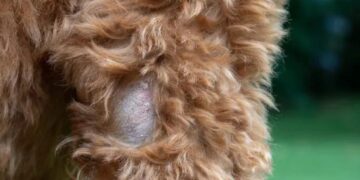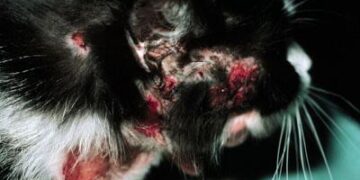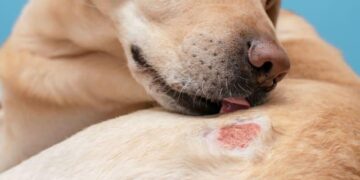Table of Contents
Introduction: The Night the Bumps Appeared
The panic set in around 10 P.M. It started with a sound—a frantic, rhythmic rubbing against the living room rug.
I looked over at Max, my goofy, lovable Labrador mix, and saw he was pushing his face into the carpet with a desperation I’d never seen before.
When I called his name, he turned, and my heart dropped.
His handsome, familiar snout was swollen and puffy, his eyes nearly lost in the swelling.
As I ran my hands over his back, I could feel them: dozens of raised, firm welts under his short coat.
It felt like I was petting a landscape of small, hard hills.
That late-night drive to the emergency vet was a blur of anxiety.
Every few minutes, I’d glance at him in the passenger seat, terrified the swelling was creeping toward his throat, imagining his breathing becoming labored.1
At the clinic, the vet was calm and efficient.
“Classic urticaria,” she said, using the clinical term for hives.
She explained it was an allergic reaction.
A quick injection of a steroid and an antihistamine, and within the hour, the swelling began to recede.3
The immediate crisis was over, and a wave of relief washed over me.
But as we drove home in the quiet of the early morning, a new feeling began to creep in: a deep, unsettling confusion.
The hives were gone, but the
problem was just beginning.
The vet had saved him from the reaction, but she couldn’t answer the one question that would echo in my mind for months: Why did this happen, and how do I stop it from ever happening again?
Part 1: The “Whack-a-Mole” Trap: My Descent into Trigger-Chasing
That first night was just the beginning of a long, frustrating journey.
The hives came back.
Not every day, not even every week, but often enough to keep me in a constant state of low-grade anxiety.
Each time those tell-tale bumps appeared, I would launch into a frantic investigation, a desperate game of “whodunit” with Max’s health.
I was determined to find the single culprit, the one trigger I could eliminate to solve the problem for good.
I didn’t know it then, but I had fallen into what I now call the “Whack-a-Mole Trap,” a maddening cycle of trigger-chasing that left me feeling exhausted, helpless, and no closer to a real solution.
This experience, I’ve learned, is painfully common among owners of dogs with recurrent hives, a testament to how conventional, linear thinking often fails us when faced with complex biological problems.
The Endless List of Suspects
My initial investigations felt like I was a detective staring at a board with hundreds of potential suspects, each one plausible.
The veterinary literature and online forums presented a bewildering array of potential triggers, making it nearly impossible to isolate a single cause.5
My list of suspects grew longer with every article I read:
- Insect Bites and Stings: This was the vet’s first guess and is considered one of the most common causes of acute hives. A bee, a wasp, a spider—anything could have bitten him on our walk.1 I scoured our yard for nests, becoming paranoid about every buzzing insect.
- Environmental Allergens: The list here was practically infinite. Was it the pollen count, which varies day by day? Was it a specific type of grass at the park? Dust mites in our home? A new cleaning product I’d used? Or even a chemical fertilizer on a neighbor’s lawn that he brushed against?.5
- Food Ingredients: This became a major focus. Online forums were filled with stories of owners who swore that switching their dog’s food solved everything.10 The most common culprits were proteins like chicken, beef, dairy, or eggs, but grains and other ingredients were also possibilities.7 I spent a small fortune on different bags of limited-ingredient dog food.
- Medications and Vaccinations: Hives can be an adverse reaction to medications or even routine vaccinations.1 I reviewed Max’s medical records, trying to find a pattern.
- Non-Allergic Triggers: This was perhaps the most confusing category. I learned that hives aren’t always a true allergic reaction. They can be triggered or worsened by factors like psychological stress (like the fireworks on the night of his first outbreak), intense exercise, exposure to heat or cold, and even direct sunlight.5
This process was maddening.
One week, I’d eliminate chicken from his diet, and he’d be fine.
I’d declare victory, only for the hives to reappear two weeks later.
Then I’d blame the pollen, keeping him inside on high-pollen days, but he’d break out on a day with a low count.
I was playing a game of Whack-a-Mole; every time I thought I’d hammered down the cause, another one would pop up somewhere else.
The fundamental flaw in my approach was treating Max’s complex body like a simple machine with one broken part.
I was looking for a single “root cause,” assuming a linear, A-causes-B relationship.
This simplistic view is why so many owners burn out; the problem is rarely that simple.
A Visual Field Guide: Is It Hives or Something Else?
Part of the initial panic and ongoing anxiety came from not being sure what I was looking at.
Was this rash dangerous? Was it even hives? Developing a clear visual understanding became a critical first step in managing my fear.
Hives, or urticaria, have a distinct look and feel.
They are raised, localized swellings on the skin called “wheals”.1
These bumps can range from the size of a small pea to several centimeters in diameter, and sometimes they merge into one large, swollen patch.6
A key characteristic is how they cause the fur to stick out, creating a “bumpy” or patchy-looking coat, which is often the first thing you notice on a dog with a thick coat.12
On dogs with short hair or on the less-furry belly area, you can often see the redness and distinct raised bumps more clearly.5
One of the most defining—and baffling—features of hives is their transient nature.
They can appear very suddenly, often within minutes to a few hours of exposure to a trigger, and can disappear just as quickly, usually resolving on their own within 12 to 48 hours.1
They most commonly appear on the head, neck, back, flanks, and legs, but can occur anywhere on the body.5
A major source of anxiety for any dog owner is misidentification.
Is this a simple case of hives, or is it a sign of a more persistent skin infection? To help you differentiate, here is a quick field guide to some common canine skin issues that can be confused with hives.
| Condition | Appearance | Onset & Duration | Key Differentiator |
| Hives (Urticaria) | Raised, distinct welts; skin may be red; fur sticks up. Bumps can be small or large and may merge together.5 | Sudden onset (minutes to hours); often disappears within 24-48 hours without a trace.1 | Bumps appear and disappear rapidly; they are distinct swellings rather than sores or scabs. The skin itself is often intact underneath. |
| Hot Spots (Acute Moist Dermatitis) | A single, well-defined area that is raw, red, moist, and often shiny or weeping. Associated with significant hair loss in the area.15 | Appears suddenly after a dog has been intensely licking, chewing, or scratching one specific spot.15 | A localized, intensely irritated, and often painful lesion that is wet to the touch. It’s a surface infection, not just swelling. |
| Folliculitis (Bacterial) | Pimple-like bumps (pustules), small sores, and scabs, often centered around hair follicles. Can look like “puppy acne”.16 | Develops over time; often a secondary infection resulting from allergies, mange, or injury.17 | Looks like an infection with pus-filled bumps or crusty scabs, rather than the clean, swollen welts of hives. Does not disappear quickly. |
| Ringworm (Fungal) | Typically circular patches of hair loss with scaly, sometimes red, skin in the center. The “ring” is a classic sign.17 | A fungal infection that develops more slowly and spreads. It is contagious to other pets and humans.17 | The distinctive circular pattern of hair loss is the primary sign. It may or may not be itchy and is not a sudden swelling. |
Part 2: The Epiphany: My Dog Isn’t a Machine, He’s an Ecosystem
After months of frustrating trigger-chasing, I hit a wall.
I had an Excel spreadsheet of foods, a calendar tracking pollen counts, and a cabinet full of different “hypoallergenic” shampoos.
Nothing worked consistently.
I felt like a failure.
The turning point came from a completely unexpected place.
During a deep dive into research, I stumbled upon the principles of Systems Ecology, a field that studies the complex, interconnected relationships within natural environments like forests and wetlands.18
Reading about it, a lightbulb went on.
I had been treating Max like a car, looking for a single faulty part to replace.
But he wasn’t a machine.
He was a living, breathing ecosystem.
This single shift in perspective changed everything.
It didn’t just give me a new answer; it gave me a whole new way to ask the question.
The goal was no longer to find and eliminate a single “root cause” but to understand and support the balance of his entire biological system.
Shifting from “Root Cause” to “Systemic Balance”
The conventional approach to problem-solving, both in mechanics and often in medicine, is Root Cause Analysis: find the one thing that’s broken and fix it.20
But for a chronic, recurring issue like Max’s hives, this approach had led me down a rabbit hole.
Systems Ecology offered a more sophisticated and, ultimately, more hopeful model.
The core principles of this field are simple but profound 18:
- Interconnection: All parts of an ecosystem are linked. The health of the trees affects the birds, which affects the insects, which affects the soil. A change in one area ripples through the entire system.
- Interdependence: All parts rely on each other. The flowers need the bees, and the bees need the flowers. This web of reliance is what gives the system its function.
- Feedback Loops: The output of a system influences its own input. A stable ecosystem has negative feedback loops that keep it in balance (e.g., more predators lead to fewer prey, which then leads to fewer predators). An unstable system can get caught in positive feedback loops that spiral out of control (e.g., melting ice exposes dark water, which absorbs more heat, which melts more ice).
Applying this to Max was my epiphany.
His body was an ecosystem.
His gut health (the soil), his external environment (the atmosphere), and his stress levels (the climate) were all interconnected.
Hives weren’t a sign of a single broken part.
They were a distress signal from the entire ecosystem, a sign that the system as a whole had lost its resilience and was being pushed out of balance.
This reframing was incredibly empowering.
I was no longer a frustrated mechanic looking for a single culprit.
I was an “ecosystem steward,” and my job was to nurture the overall health and balance of the system.
The Histamine Bucket: Why Reactions Seem So Random
This new ecosystem mindset also helped me solve the most confusing part of Max’s condition: the randomness.
Why would a walk in the same park cause a massive outbreak of hives one Tuesday but have no effect the following Thursday? The answer lies in what I now call the “Histamine Bucket” analogy.
In an allergic reaction, specialized immune cells release a flood of chemicals, most notably histamine.
It’s this histamine that causes blood vessels to dilate and leak fluid into the skin, creating the swollen welts we see as hives.7
Now, imagine that every dog has an invisible “histamine bucket.” Different triggers—allergic and non-allergic—add “water” to this bucket.
- A bit of pollen on the wind? A splash of water goes in.
- A treat with a chicken byproduct? Another splash.
- A stressful encounter with another dog? A little more water.
- A hot, humid day? Another splash.
A single splash might not be enough to cause a problem.
The bucket has capacity.
But when multiple triggers happen in a short period, the bucket fills up.
The hives don’t appear until the bucket overflows.
This explains the seeming randomness perfectly.
The walk on Thursday might have been fine because Max’s bucket was only half-full.
But the walk on Tuesday, which was identical, caused an outbreak because his bucket was already filled to the brim by other factors—maybe he had a treat he was sensitive to earlier that day, or maybe the stress of a passing thunderstorm had added to his load.
This concept moves the problem from a simple “A causes B” equation to a more realistic model of cumulative load: A + C + D + F overflows the system, resulting in B.
The goal, then, is not just to eliminate one trigger, but to keep the overall level of the bucket as low as possible at all times.
Part 3: The Three Pillars of Your Dog’s Ecosystem
Armed with my new understanding of Max as an ecosystem and the concept of the Histamine Bucket, I stopped my frantic, single-minded trigger-chasing.
Instead, I started focusing on strengthening the three core pillars of his biological system.
This proactive approach aimed to build his resilience from the inside out, making his “histamine bucket” larger and less likely to overflow.
Pillar I: The Soil (Internal Health: Gut, Diet, and Immunity)
In any ecosystem, the health of the soil determines the health of everything that grows from it.
For a dog, the “soil” is their internal environment: their gut, their diet, and their immune system.
A staggering amount of the immune system is located in the gut, creating a powerful “gut-skin axis”.8
When the gut microbiome is out of balance (a state called dysbiosis), it can lead to systemic inflammation that manifests on the skin as itching, rashes, and hives.
Nurturing this internal foundation became my first priority.
- Food as Information, Not Just Fuel: I learned to distinguish between a true food allergy (a specific immune response) and a food sensitivity (which can cause inflammation without a classic allergic reaction).8 To figure out what was contributing to Max’s histamine load, I committed to a strict
elimination diet. This is more than just switching brands; it’s a diagnostic tool. Under my vet’s guidance, we chose a prescription diet with a “hydrolyzed” protein, where the protein molecules are broken down so small that the immune system doesn’t recognize them as a threat.11 An alternative is a diet with a truly novel protein—something the dog has never eaten before, like kangaroo or venison. The key is absolute strictness for 6-8 weeks: no other treats, no table scraps, no flavored medications.5 After the trial period, if symptoms have improved, you can reintroduce old ingredients one by one to see which one causes a reaction. For Max, we discovered that while he didn’t have a full-blown allergy, beef was a significant contributor to his overall inflammation. - Cultivating the Internal Garden: Alongside the diet change, I began incorporating supplements to support his gut and immune health, effectively “amending the soil.”
- Probiotics and Digestive Enzymes: These help to restore a healthy balance of beneficial bacteria in the gut microbiome, improving digestion and reducing systemic inflammation. Specific strains like Bifidobacterium animalis and Lactobacillus acidophilus have been shown to be beneficial for dogs.22 Digestive enzymes help break down food more efficiently, reducing the chance of undigested proteins causing an immune response.22
- Bovine Colostrum: This is the “first milk” produced by cows and is rich in compounds that help regulate the immune system. Specifically, it contains proline-rich polypeptides (PRPs) that can help prevent the immune system from overreacting to harmless allergens.22 It’s best given on an empty stomach for maximum absorption.
- Omega-3 Fatty Acids: Sourced from things like fish oil or green-lipped mussel oil, Omega-3s are powerful natural anti-inflammatories. They work by helping to block the production of inflammatory chemicals in the body, which can significantly reduce the itching and swelling associated with allergic reactions.22
Pillar II: The Atmosphere (External Environment & Allergen Load)
The “atmosphere” of your dog’s ecosystem is everything their body comes into contact with externally.
This includes the air they breathe, the ground they walk on, and the substances that touch their skin.
The goal for this pillar is to reduce the total “allergen load”—the constant influx of things that add water to the Histamine Bucket.
- Managing Environmental Triggers: For dogs with environmental allergies (atopy), this is a critical component. While you can’t eliminate pollen from the air, you can reduce your dog’s exposure and the impact it has.8
- Practical Steps for a Cleaner Atmosphere:
- Strategic Wiping and Rinsing: Wiping down Max’s paws, belly, and face with a damp cloth after every walk became a non-negotiable ritual. This simple act removes a significant amount of pollen and other surface allergens before he can lick them off or absorb them through his skin.25
- Therapeutic Bathing: Frequent bathing with a high-quality, hypoallergenic, or medicated shampoo helps to wash away allergens and soothe the skin. Shampoos containing oatmeal are particularly good for this.6
- Creating a Safe Haven Indoors: We started using a HEPA air purifier in the main living area and our bedroom to filter out dust mites, dander, and pollen from the indoor air. I also became more mindful of cleaning products, switching to unscented, natural options to avoid chemical irritation.27
- Unyielding Flea Control: This is crucial. Even if a dog isn’t specifically allergic to flea saliva, flea bites are inflammatory. They add an unnecessary burden to an already taxed immune system.8 Maintaining a strict, year-round, vet-approved flea prevention plan is a foundational part of lowering the overall allergen load.29
Pillar III: The Climate (Systemic Stressors & The Detective’s Work)
The “climate” refers to the overarching, often invisible forces that affect the entire ecosystem.
This includes systemic stressors like heat and anxiety, but most importantly, it involves your role as the owner.
This is where you shift from being a passive observer to an active investigator.
- Accounting for Non-Allergic Triggers: I started paying close attention to the factors that weren’t “allergies” but were clearly contributing to Max’s histamine bucket. On very hot days, I would ensure our walks were short and during the coolest parts of the day. I became more aware of his stress levels, recognizing that events like thunderstorms or having lots of visitors were potential “triggers” that could lower his threshold for a reaction.5
- Becoming a Health Detective: The Systems Ecology model gave me the “what”—the map of the interconnected system. But to understand what was happening in Max’s specific ecosystem, I needed a “how.” This is where I embraced the role of the “Health Detective”.30 A detective doesn’t guess; they gather clues, assume nothing, challenge everything, and look for patterns. My primary tool became a simple journal. In it, I systematically tracked:
- Inputs (Pillar I): Every meal, every treat, every supplement.
- Exposures (Pillar II): Where we walked, the weather, any new environments, contact with other animals.
- Events (Pillar III): Vet visits, thunderstorms, car rides, visitors—anything out of the ordinary.
- Outputs: The exact timing, location on his body, and severity of any hive outbreaks.
Over a few months, patterns began to emerge from the “clues.” I could see that a long, hot afternoon hike followed by a beef-based treat was almost a guaranteed recipe for a minor outbreak.
I noticed that his reactions were worse during the spring, when his environmental allergen load was highest.
This detective work, guided by the ecosystem map, allowed me to connect the dots between the pillars.
It transformed me from a helpless victim of circumstance into an empowered investigator who understood my dog’s unique thresholds and patterns.
Part 4: Your Integrated Toolkit: Emergency Brakes and Long-Term Maintenance
Putting this all together requires a practical, balanced toolkit.
One of the biggest sources of confusion for owners is the apparent conflict between conventional veterinary medicine and holistic or natural approaches.
The ecosystem framework resolves this.
They aren’t in opposition; they are different tools for different jobs.
Conventional drugs are your powerful, fast-acting emergency brakes.
Holistic support and lifestyle management are your long-term maintenance, keeping the system running smoothly so you rarely need to slam on those brakes.
The Emergency Protocol: When to Hit the Brakes, Hard
There are times when a hive outbreak is more than just uncomfortable—it’s a true medical emergency.
A severe, whole-body allergic reaction is called anaphylaxis, and it can be life-threatening.2
In these moments, the goal is not to gently nurture the ecosystem; it’s to stop a catastrophic, out-of-control inflammatory cascade immediately.
This is where conventional medications like injectable antihistamines and corticosteroids are indispensable.
They are the system’s emergency brakes.
While they don’t “fix” the underlying imbalance, they can halt a dangerous reaction in its tracks, buying you the time needed to seek veterinary care and for the system to stabilize.3
It’s crucial to know the signs that require you to pull this emergency brake and head to the nearest emergency vet without hesitation.
Signs of a Severe Reaction (Anaphylaxis) Requiring Immediate Emergency Care:
- Significant Facial or Throat Swelling (Angioedema): This is the most alarming sign. Swelling of the muzzle, lips, eyelids, or throat can obstruct the airway.1
- Difficulty Breathing: Look for wheezing, noisy breathing, or frantic panting that seems out of proportion to the situation.2
- Pale or Blue-Tinged Gums: Lift your dog’s lip. Healthy gums are pink. Gums that are pale, white, or have a bluish tint indicate a lack of oxygen and a circulatory crisis.2
- Systemic Signs: Sudden and severe vomiting, diarrhea, profound weakness, or collapse are all red flags for anaphylaxis.2
The Soothing and Support Arsenal
For mild to moderate flare-ups, and for long-term skin support, you have an arsenal of at-home therapies that can soothe symptoms and improve the resilience of the skin—the ecosystem’s outer barrier.
- Topical Soothers:
- Cold Compresses: A simple and effective way to provide immediate relief from itching and reduce swelling. Soak a clean cloth in cold water or wrap ice in a towel and apply it gently to the affected areas for several minutes at a time.6
- Therapeutic Baths: A warm (not hot) bath can be incredibly soothing. Adding specific ingredients can boost the anti-inflammatory effect 35:
- Oatmeal: Grind plain, uncooked oatmeal into a fine powder and add it to the bathwater. It’s a classic, safe remedy for calming irritated skin.
- Herbal Teas: Steeping chamomile or green tea bags in the bathwater can also help cool and soothe the skin due to their natural anti-inflammatory properties.
- Apple Cider Vinegar (ACV) Rinses: ACV has natural antiseptic and antifungal properties. A rinse made of 50% ACV and 50% water can help with itchy skin. Crucial Caveat: Never apply ACV to raw or broken skin, as it will sting painfully.35 It’s best for intact, itchy skin.
- Coconut Oil: Applied topically, high-quality coconut oil can act as a moisturizer and help support the skin’s natural barrier. Its antibacterial and antifungal properties can also be beneficial.35
To make this practical, here is a matrix to help you decide what to do based on what you’re seeing.
It combines the emergency protocol with the supportive care, giving you a clear, tiered response plan.
| Scenario | Visual Signs | Level of Urgency | Immediate Action | Long-Term System Support |
| Mild Flare-Up | A few small, localized bumps on the back or belly. Dog is not in distress and itching is minimal. | Monitor Closely | Apply a cold compress to the area. Consider giving an oatmeal bath for comfort. Call your non-emergency vet line for advice on an appropriate over-the-counter antihistamine dose (e.g., Benadryl).34 | Journal the incident meticulously. Review recent inputs and exposures from the last 24 hours to identify potential contributors (Pillar III). |
| Moderate Flare-Up | Widespread hives covering a large area of the body. Intense itching causing distress. No facial swelling or breathing issues. | Urgent Vet Visit | Call your veterinarian immediately and schedule a same-day appointment. This level of reaction often requires injectable antihistamines and/or steroids for rapid relief.3 | This is a clear signal the “Histamine Bucket” has overflowed. A comprehensive review of all three pillars is needed. This is a good time to seriously consider a strict elimination diet (Pillar I). |
| Severe/Anaphylactic | Any swelling of the face, muzzle, or throat. Any difficulty breathing, wheezing, pale gums, vomiting, or collapse. | EMERGENCY | Go to the nearest emergency veterinary hospital IMMEDIATELY. Do not wait. This is a potentially life-threatening situation.1 | Once your dog is stable, work closely with your vet or a veterinary dermatologist on a comprehensive prevention plan. This may include formal allergy testing and immunotherapy (allergy shots).1 |
Conclusion: Becoming Your Dog’s Ecosystem Steward
Today, Max is a happy, thriving dog.
The hives haven’t vanished from our lives entirely, but they are no longer the terrifying, mysterious monster they once were.
They are now rare, mild, and brief—a quiet signal from his ecosystem that something is a little off-balance, a nudge for me to check my detective’s journal.
The panic is gone, replaced by a quiet confidence.
I have the framework to understand and the tools to respond.
The journey from that first frantic night at the emergency vet to this place of calm competence was transformative, not just for Max, but for me.
It forced me to look deeper, to move past the simplistic, frustrating search for a single villain, and to embrace a more holistic, interconnected view of health.
If you are reading this, you are likely standing where I once stood—feeling worried, confused, and maybe a little helpless.
My hope is that this story offers you a new map.
Your dog is not a broken machine.
They are a dynamic, complex ecosystem.
By shifting your perspective from a trigger-chasing mechanic to a wise and observant ecosystem steward, you can move beyond simply fighting the bumps.
You can begin the profound and rewarding work of cultivating a deep, resilient foundation of health for your best friend.
It is a journey from fear to empowerment, from confusion to clarity, and it is a journey you are more than capable of taking.
Works cited
- Dog Hives: What They Are and How To Treat Them | PetMD, accessed July 25, 2025, https://www.petmd.com/dog/conditions/skin/hives-dogs-causes-symptoms-and-treatment-options
- Allergic Hives in Dogs: When They’re an Emergency & How to Help, accessed July 25, 2025, https://gsvs.org/blog/allergic-hives-dogs-emergency/
- Hives (Urticaria) in Dogs – VCA Animal Hospitals, accessed July 25, 2025, https://vcahospitals.com/know-your-pet/urticaria-or-hives-in-dogs
- HIVES | Dog Food Advisor, accessed July 25, 2025, https://www.dogfoodadvisor.com/forums/topic/hives/
- Hives in Dogs | Small Door Veterinary, accessed July 25, 2025, https://www.smalldoorvet.com/learning-center/medical/hives-in-dogs/
- Hives in Dogs: What They Mean & What Causes Them | Monroe Vets, accessed July 25, 2025, https://www.monroeveterinaryclinic.com/site/blog/2024/03/30/hives-dogs
- Dog Hives (Urticaria | welts): Causes, Diagnosis & Treatment – The Vets, accessed July 25, 2025, https://thevets.com/blog/dog-hives/
- Allergies in Dogs: Symptoms, Triggers, and How to Help Your Pup – Animal Biome, accessed July 25, 2025, https://www.animalbiome.com/blogs/dog/allergies-in-dogs-symptoms-triggers-and-how-to-help-your-pup
- CANINE ALLERGY – Pines Meadow Veterinary Clinic, accessed July 25, 2025, https://pinesvet.com/canine-allergy/
- Experience with a super itchy dog? – Page 2 – Sitter Questions …, accessed July 25, 2025, https://forum.trustedhousesitters.com/t/experience-with-a-super-itchy-dog/55615?page=2
- Allergies in Dogs – Dog Owners – Merck Veterinary Manual, accessed July 25, 2025, https://www.merckvetmanual.com/dog-owners/skin-disorders-of-dogs/allergies-in-dogs
- Hives on Dogs: What They Mean & What Causes Them | Orange …, accessed July 25, 2025, https://www.animalfriendsdermatology.com/site/blog/2024/01/30/hives-dogs
- Hives in Pets: What They Mean and What Causes Them | VetDERM Clinic, accessed July 25, 2025, https://www.vetdermclinic.com/hives-in-pets-what-they-mean-and-what-causes-them/
- Hives and Rashes (Urticaria) in Dogs – Dog Owners – Merck Veterinary Manual, accessed July 25, 2025, https://www.merckvetmanual.com/dog-owners/skin-disorders-of-dogs/hives-and-rashes-urticaria-in-dogs
- 11 Common Types of Canine Dermatitis and Rashes with Pictures …, accessed July 25, 2025, https://lavengel.com/pages/skin-issues-rashes-and-dermatitis
- 15 Types of Dog Skin Diseases With Pictures – The Spruce Pets, accessed July 25, 2025, https://www.thesprucepets.com/photos-of-two-canine-dermatology-patients-4121974
- Pictures of Skin Problems in Dogs: From Dandruff to Ringworm, accessed July 25, 2025, https://www.webmd.com/pets/dogs/ss/slideshow-skin-problems-in-dogs
- Systems Ecology Principles → Term, accessed July 25, 2025, https://climate.sustainability-directory.com/term/systems-ecology-principles/
- Systems Ecology in Environmental Philosophy – Number Analytics, accessed July 25, 2025, https://www.numberanalytics.com/blog/systems-ecology-environmental-philosophy
- Root Cause Analysis: Are You Treating Symptoms or Curing the Disease?, accessed July 25, 2025, https://taproot.com/root-cause-analysis-are-you-treating-symptoms-or-curing-the-disease/
- How Do You Determine The Root Cause – GreyCampus, accessed July 25, 2025, https://www.greycampus.com/blog/quality-management/how-do-you-determine-the-root-cause
- Holistic Treatment for Dogs with Allergies – Nikolaus Nature, accessed July 25, 2025, https://nikolausnature.com/blogs/dog-health/holistic-treatment-for-dogs-with-allergies
- 7 Natural Home Remedies For Dog Allergies, accessed July 25, 2025, https://thenaturaldogstore.com/blogs/health/7-natural-home-remedies-for-dog-allergies
- Why Your Dog Has Hives and How to Treat Them – Native Pet, accessed July 25, 2025, https://nativepet.com/blogs/health/dog-hives
- Allergies in Dogs: Symptoms, Causes, and Treatment – PetMD, accessed July 25, 2025, https://www.petmd.com/dog/general-health/food-allergies-vs-seasonal-allergies-dogs
- Treatment Options for Allergies in Pets – Poland Veterinary Centre, accessed July 25, 2025, https://www.polandvet.com/sites/site-1402/documents/Treatment-Options-for-Allergies-in-Pets.pdf
- A Complete Guide to Boxer Skin Issues (and Fixes!) – Wild Earth Pet Food, accessed July 25, 2025, https://wildearth.com/blogs/dog-knowledge/a-complete-guide-to-boxer-skin-issues-and-fixes
- Canine Allergies: Most Common Causes, Best Tests, and Effective Treatments, accessed July 25, 2025, https://www.whole-dog-journal.com/health/canine-allergies-most-common-causes-best-tests-and-effective-treatments/
- Different Types of Dog Allergies: How to Identify and Treat Them – American Kennel Club, accessed July 25, 2025, https://www.akc.org/expert-advice/health/dog-allergies-symptoms-treatment/
- How to think like a detective | Psyche Guides, accessed July 25, 2025, https://psyche.co/guides/how-to-solve-problems-by-thinking-like-a-detective
- a methodological metaphor – what detective are you? – patter, accessed July 25, 2025, https://patthomson.net/2013/02/07/a-methodological-metaphor-what-detective-are-you/
- Medical mysteries and detective doctors: Metaphors of medicine …, accessed July 25, 2025, https://hekint.org/2017/03/04/medical-mysteries-and-detective-doctors-metaphors-of-medicine-2/
- Hives in Dogs: What To Do If Your Dog Experiences an Allergic Reaction, accessed July 25, 2025, https://www.portcityvet.com/blog/what-to-do-if-your-dog-experiences-an-allergic-reaction
- How to Treat Dog Hives at Home, accessed July 25, 2025, https://www.whole-dog-journal.com/health/how-to-treat-dog-hives-at-home/
- 5 Natural Remedies to Help Your Itchy Dog | AKC Pet Insurance, accessed July 25, 2025, https://www.akcpetinsurance.com/blog/5-natural-remedies-to-help-your-itchy-dog






